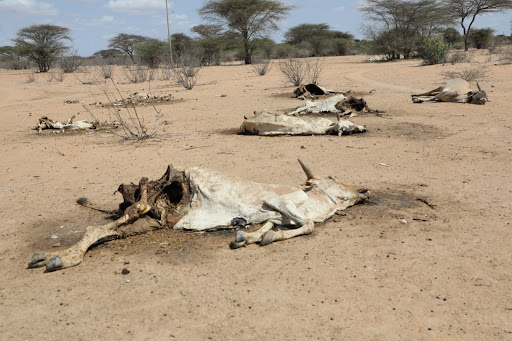
 Carcass of death livestock/FILE
Carcass of death livestock/FILEAs the world marked International Day of Clean Air for Blue Skies on September 7, the World Meteorological
Organisation released a stark reminder: air quality and climate change
are inseparable.
The Air Quality and Climate Bulletin paints a complex picture of how tiny airborne particles— aerosols—drive wildfires, winter fog, shipping emissions and urban smog.
Some warm the atmosphere and melt glaciers, while others
briefly cool the planet but return as acid rain. Together, they form an
intricate web linking human activity to environmental and health crises.
“Climate change and air quality cannot be addressed in isolation. They go hand-in-hand and must be tackled together,” WMO deputy secretary general Ko Barrett said.
Fossil fuel burning,
for example, releases not only greenhouse gases but also pollutants like black
carbon and nitrous oxide that worsen climate change in a feedback loop.
The human toll is immense. Ambient air pollution claims more than 4.5 million lives annually, according to World Health Organization.
Agriculture, industry, transport—and increasingly, wildfires—remain the biggest sources of particulate matter, one of the most dangerous pollutants. Particulate matter is a complex mix of microscopic solid particles and liquid droplets suspended in the air, including dust, dirt, soot, smoke and other pollutants like sulfates and nitrates.
They are categorised by size, with PM2.5 (particles less than 2.5 micrometres) being particularly harmful because they can be inhaled deep into the lungs and even the bloodstream.
For the first time, WMO’s 2025 edition included data from three models tracking PM2.5 anomalies in 2024 against a two-decade baseline.
The findings are sobering. While eastern China
recorded improvements thanks to sustained action, northern India remained a
hotspot. Wildfires pushed levels above average in Canada, Siberia and central
Africa, with the Amazon basin recording the worst anomaly amid record fires and
drought.
Even progress carries paradoxes. Regulations slashing sulphur in shipping fuels have saved lives and reduced asthma cases, but also reduced the cooling effect of sulphates, nudging global warming upward.
Meanwhile, winter fog on the Indo-Gangetic Plain—home to 900
million people—has grown more persistent, no longer just a seasonal weather
event but a signal of human-driven pollution.
WMO stresses the urgency of integrated solutions. Satellites
provide a global view, but ground-based monitoring, especially in developing
countries, remains critical. From ozone studies in South America to pollen
forecasts in Europe and deposition research in Africa, the report calls for
global cooperation to protect ecosystems, health and economies.
“Climate impacts and air pollution respect no national borders,” Barrett warned.
“Only international collaboration
and improved monitoring can confront this global challenge.”
Instant analysis
Air quality and climate change are deeply intertwined, creating a cycle that amplifies global risks. The WMO’s latest bulletin shows how aerosols, wildfires, shipping emissions and urban pollution affect human health and planetary warming. While progress has been made in regions like eastern China, hotspots such as northern India and the Amazon basin highlight persistent challenges. Policies curbing sulphur in fuels have improved public health but also reduced cooling effects, slightly accelerating warming. The report underscores that pollution and climate do not respect borders, demanding stronger international cooperation, monitoring infrastructure and integrated action to protect lives and economies.















